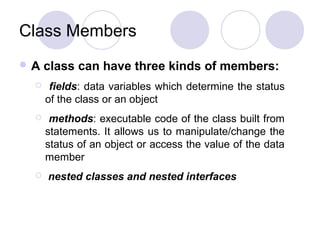Oops
- 1. Lecture 2: Object Oriented Programming I
- 2. Procedural vs. Object-Oriented Programming The unit in procedural programming is function, and unit in object-oriented programming is class Procedural programming concentrates on creating functions, while object-oriented programming starts from isolating the classes, and then look for the methods inside them. Procedural programming separates the data of the program from the operations that manipulate the data, while object-oriented programming focus on both of them figure1: procedural figure2: object-oriented
- 3. Concept of Class and Object “Class” refers to a blueprint. It defines the variables and methods the objects support “Object” is an instance of a class. Each object has a class which defines its data and behavior
- 4. Class Members A class can have three kinds of members: fields: data variables which determine the status of the class or an object methods: executable code of the class built from statements. It allows us to manipulate/change the status of an object or access the value of the data member nested classes and nested interfaces
- 5. Sample class class Pencil { public String color = “red”; public int length; public float diameter; public static long nextID = 0; public void setColor (String newColor) { color = newColor; } }
- 6. Sample class class Pencil { public String color = “red”; public int length; public float diameter; public static long nextID = 0; public void setColor (String newColor) { color = newColor; } }





